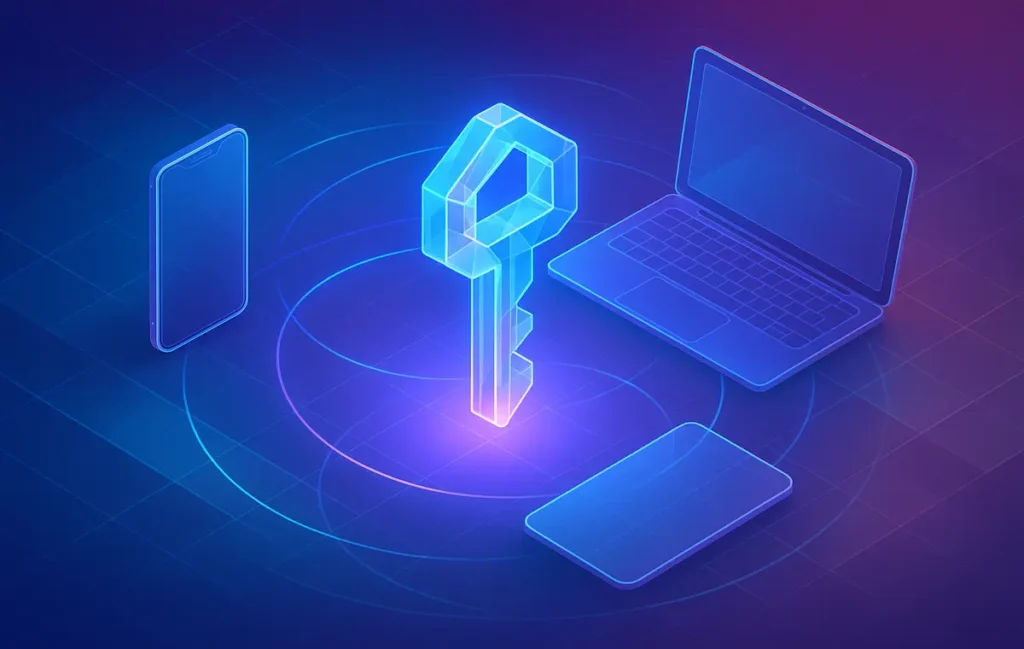🎯 Intro
Ever tried logging into your online banking app on your phone, then switching to your laptop, only to be ambushed by a storm of SMS codes and push notifications? That constant friction is one of the reasons digital authentication has remained a pain point for both users and businesses. Enter passkeys—a frictionless, phishing-resistant way to log in that could finally kill the traditional password.
But here’s the real test: no matter how secure or futuristic passkeys seem, if they don’t sync flawlessly across devices, they fail in practice. Whether you’re bouncing between iOS, Android, Windows, or macOS, you expect one smooth experience. And that’s exactly why the evolution of password managers matters right now. This post unpacks how passkeys actually work in practice, why sync is the battlefield, and which managers are already nailing it.
🔍 What Are Passkeys in Practice?
Passkeys are not just a rebranding of passwords—they’re an entirely new authentication model. Instead of relying on a string of characters stored in a database (and vulnerable to phishing, leaks, or brute force attacks), passkeys are built on public-key cryptography. Your private key never leaves your device, and authentication happens via a cryptographic handshake.
Big Tech isn’t betting on passkeys by accident. Apple has already embedded them into iCloud Keychain, Google is rolling out passkey support across Gmail and Chrome, and Microsoft is building native Windows Hello integration. The goal is simple: eliminate passwords while still giving users a simple, familiar login experience.
As much as passkeys strengthen authentication, they’re only one layer in a much larger cybersecurity puzzle. With AI-driven phishing kits and automated intrusion tools becoming mainstream, it’s critical to think beyond login credentials. In our analysis of Cybersecurity in 2025: AI-Powered Defenses and Emerging Threats, we show how AI is both a weapon and a shield—and why pairing passkeys with AI-powered monitoring is the real way forward.
🔄 Why Cross-Device Sync is the Core Problem
While passkeys solve phishing, they introduce a new challenge: portability. Imagine creating a passkey for your Amazon account on an iPhone and then trying to log in on a Windows laptop. Unless your manager syncs seamlessly, you’re locked out—or stuck in a maze of QR code transfers.
Cross-device sync has always been the Achilles heel of authentication. Password managers historically stepped in to fill this gap, offering encrypted vaults that sync logins across devices. But now, they must evolve beyond saving passwords—they need to orchestrate passkeys across ecosystems.
Even the best password manager can’t protect you from every angle of attack. Phishing-resistant passkeys are powerful, but they should sit inside a broader defense strategy. In Pro Tips to Protect Against Cyber Threats: Build a Multi-Layered Defense, we break down how firewalls, VPNs, and endpoint detection complement passkeys to form a complete security stack.
🛠️ Password Managers That Nail It
Some password managers are already adapting aggressively to passkeys. Let’s look at how the leaders are handling real-world sync, with pros, cons, and use cases that actually matter.
🔑 1Password
1Password has been one of the first movers in making passkeys practical. Its secret sauce is 1Password X, which integrates with browsers across operating systems. That means if you create a passkey on your iPhone, it can follow you to your Linux workstation or Windows laptop. Users on Reddit note that this cross-ecosystem flexibility is the single biggest reason they stick with 1Password.
-
Pros: Excellent UI, wide platform coverage, fast to roll out new standards.
-
Cons: Paid-only; can feel heavy for single users.
-
Real Use Case: A remote team using macOS and Windows machines can share passkey-enabled vaults without worrying about sync gaps.
🔑 Dashlane
Dashlane has leaned into passkeys as part of its pitch for a “passwordless future.” Its browser extension is strong, but mobile sync can be inconsistent across Android/iOS ecosystems.
-
Pros: Great browser integration, solid autofill.
-
Cons: Limited offline support; syncing sometimes lags.
-
Real Use Case: Best suited for users who live in browsers and rarely switch ecosystems.
🔑 Bitwarden
Bitwarden is the open-source hero in this race. Its biggest advantage is transparency—you can actually audit how passkeys are stored. Sync works well, but it sometimes requires manual setup, making it less “plug and play.”
-
Pros: Open-source, affordable, transparent.
-
Cons: Setup complexity for non-tech users.
-
Real Use Case: Developers or security-conscious users who want control over where their keys are hosted.
🔑 NordPass
Backed by the NordVPN brand, NordPass has gone heavy on marketing but is still catching up in passkey polish. Sync is stable, but its ecosystem breadth isn’t yet on par with 1Password.
-
Pros: Clean design, good integration with NordVPN bundle.
-
Cons: Slower rollouts of new passkey features.
-
Real Use Case: Users already in the NordVPN ecosystem who want bundled security.
🔑 iCloud Keychain
Apple’s ecosystem play. iCloud Keychain handles passkeys elegantly—if you live inside the Apple bubble. But step outside, and you hit walls.
-
Pros: Seamless within iOS/macOS.
-
Cons: Locked to Apple devices.
-
Real Use Case: iPhone + MacBook users who never touch Windows or Android.
💡 Nerd Tip: Before switching to a new password manager, confirm whether your entire ecosystem—Windows, Android, iOS—supports full passkey export/import. Half-solutions can lock you in more than passwords ever did.
📈 Real ROI Breakdown
Time saved per login might feel small, but it compounds fast. A Forrester study found that workers lose an average of 11 hours per year just resetting forgotten passwords. Multiply that across a team of 500 employees, and you’re talking nearly 5,500 hours of wasted productivity. Passkeys cut this number dramatically by eliminating password resets altogether.
From a security perspective, phishing accounts for over 90% of breaches, according to Verizon’s DBIR report. Passkeys shut that vector down by design. Businesses adopting passkeys through managers like 1Password or Bitwarden can expect a double ROI: reduced IT support costs and fewer security incidents.
And there’s the psychological ROI: customers trust platforms that don’t constantly lock them out. This translates into higher engagement and retention—critical for SaaS and e-commerce brands.
If you’re looking at the bigger landscape, our guide on AI-Powered Security Tools explains how automation is boosting this ROI even further.
🚀 Implementation Guide
Transitioning to passkeys isn’t rocket science, but it requires a structured approach.
Step 1: Choose the right manager. If you’re ecosystem-locked (Apple, Google), your native option may suffice. Otherwise, opt for a cross-platform tool like 1Password or Bitwarden.
Step 2: Enable passkeys + sync. Make sure passkey support is toggled on in both your mobile and desktop apps, and test autofill in multiple browsers.
Step 3: Test across ecosystems. Don’t assume it works—create a passkey on one device, then attempt login on another.
Step 4: Plan backups. Store a recovery code offline, or designate a backup device. This is critical for avoiding total lockouts.
The conversation around passkeys isn’t just for business or finance—it’s also crucial in the smart home space. Every IoT device you connect introduces a new identity surface. As we explore in Best Home Automation Apps for Smart Living, managing a multi-device ecosystem safely means your authentication has to sync as smoothly as your lights and thermostats.
⚠️ Challenges & Solutions
Even with momentum, challenges remain. Compatibility is fragmented: Apple’s iCloud Keychain works beautifully inside its ecosystem but leaves gaps elsewhere. Similarly, Android integration can lag on Windows PCs.
Backup and recovery remain under-discussed. Lose your phone without a backup strategy, and you could lose access to accounts entirely. Managers must make recovery intuitive, not terrifying.
Finally, adoption among non-tech users will take time. Many still feel safer clinging to “password123” than learning something new. The best managers will bridge this adoption curve with education, not just features.
Freelancers juggle multiple devices daily—switching from laptops to phones, sometimes even tablets. If authentication fails across platforms, productivity takes a hit. In Essential Apps for Freelancers and Side-Hustlers: The Field-Tested, No-Fluff Toolkit, we spotlight apps that help keep workflows synced and secure, including password managers that already support passkeys.
⚡ Test Passkeys in Action
Try leading managers like 1Password, Dashlane, or NordPass with free trials. Experience seamless sync and decide which one truly fits your workflow.
🌐 Industry Adoption & Signals
Passkeys are no longer just a whitepaper concept—they’re live in production across some of the biggest digital platforms. PayPal rolled out passkey logins for its global users in 2023, and adoption numbers showed a steady uptick with millions of users opting in. eBay, Google Accounts, and Microsoft Outlook have also integrated passkeys as default login options. These aren’t experiments—they’re market signals that mass adoption is happening.
The industry shift also shows a powerful psychological trend. When companies like Google and Apple present passkeys as the “normal way” to log in, users rarely question the change. Just like biometric unlocks became standard with Face ID and fingerprint sensors, passkeys are normalizing faster than expected. For businesses evaluating their security stack, this signals one thing: resisting passkeys won’t be a neutral choice. Falling behind could create friction that competitors are already removing.
💡 Nerd Tip: If your bank or SaaS tool doesn’t yet support passkeys, ask them. Early demand is a signal companies actually track.
For remote teams, seamless authentication is part of productivity. Nobody wants to lose ten minutes re-verifying every time they switch devices during a meeting. In AI Task Automation Tools for Remote Teams, we show how cross-platform automation tools combine with modern authentication like passkeys to protect data while keeping workflows frictionless.
📊 Benchmark Table: Who Nails Cross-Device Sync?
To cut through the noise, here’s a compact benchmark comparing leading managers on ecosystem coverage and sync reliability:
| Password Manager | Ecosystem Coverage | Sync Reliability |
|---|---|---|
| 1Password | Windows, macOS, iOS, Android, Linux | High |
| Dashlane | Windows, macOS, iOS, Android | Medium |
| Bitwarden | Windows, macOS, iOS, Android, Linux (self-host options) | High (with manual setup) |
| NordPass | Windows, macOS, iOS, Android | Medium |
| iCloud Keychain | macOS, iOS only | High (inside Apple only) |
This isn’t just about “does it work”—it’s about how reliable the experience is across ecosystems. The table highlights why 1Password and Bitwarden currently lead the race, while Apple’s solution remains excellent but closed.
🏢 The Enterprise Angle
For enterprises, the promise of passkeys is more than convenience—it’s economics. Gartner research notes that password reset requests account for up to 40% of IT help desk volume. Each reset costs an average of $70 when factoring in employee downtime and IT staff time. For a company with 1,000 employees, that’s easily $280,000 per year wasted on nothing but password resets.
By adopting passkeys, enterprises can cut those costs sharply. Phishing-related breaches also drop, reducing compliance and insurance risks. For sectors bound by GDPR, HIPAA, or ISO 27001, passkeys align well with compliance requirements by ensuring authentication is phishing-resistant and less reliant on human behavior.
Forward-looking CIOs are already evaluating whether tools like 1Password Enterprise or Dashlane Business can integrate passkeys into Single Sign-On (SSO) systems. For SMBs, the ROI is even more immediate: less downtime, fewer customer lockouts, and a stronger brand reputation for trust.
🌍 Global Standards & The Role of FIDO
Behind the rise of passkeys sits the FIDO Alliance, a consortium that includes Google, Apple, Microsoft, PayPal, and hundreds of other stakeholders. Their mission is to build open authentication standards that any platform can adopt. This matters because the future of authentication can’t be locked inside one walled garden—interoperability is non-negotiable.
FIDO2 and WebAuthn standards are what make passkeys function across browsers and operating systems. When you create a passkey on an iPhone and log in on Chrome for Windows, that handshake only works because of these standards. Without them, passkeys would have splintered into yet another ecosystem war.
For end-users, this means confidence: you’re not betting on a single company’s technology. For businesses, it means you can roll out passkeys today knowing they’re aligned with a global roadmap. NerdChips predicts that by 2027, over 70% of major SaaS platforms will offer passkeys as a standard login option.
🧪 Failure Scenarios & Lessons Learned
It’s easy to sell passkeys as perfect, but real-world failures highlight where users and managers must stay cautious. Consider a user who created all their passkeys on an iPhone, then lost the device without setting up recovery. Without iCloud sync or a backup device, they were locked out entirely. Recovery involved hours of customer support with multiple services, and in some cases, accounts were unrecoverable.
Another common scenario: sync glitches. Some users reported that passkeys created in Chrome on Android did not appear in their Windows desktop vault until reauthentication was forced. While rare, these experiences create fear among non-technical users.
The lesson? Always test your setup across devices and prepare recovery plans. Managers must make the process of exporting, importing, and backing up passkeys intuitive. Until then, hybrid strategies (using passkeys where supported but keeping strong passwords as backup) remain a practical step.
🎯 Before you close the tab, let’s be real: the difference between reading about passkeys and actually trying them is huge. The first login you complete without typing a password feels like magic.
Try Passkeys Today
Download 1Password or Bitwarden, enable passkey sync, and test logging in across your phone and laptop. See how much friction disappears when passwords vanish.
📬 Want More Smart Security Tips?
Join our free newsletter and get weekly insights on passkeys, AI security tools, and digital productivity—delivered straight to your inbox.
🔐 100% privacy. No noise. Just value-packed security insights from NerdChips.
🧠 Nerd Verdict
Passkeys are not just a buzzword—they are the next user experience leap in authentication. Password managers that get cross-device sync right are not just competing in the security market; they’re defining the future of how we log in.
At NerdChips, our take is simple: in five years, you won’t be asking which password manager handles passkeys—you’ll be asking which ones survived the shift.
❓ FAQ: Nerds Ask, We Answer
💬 Would You Bite?
Would you trust a world where passwords no longer exist—or do you still prefer to keep a backup “just in case”?
Crafted by NerdChips for creators and teams who want their best ideas to travel the world.



